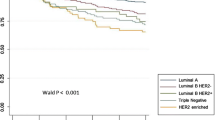Abstract
This study investigated the changes, if any, in the level of expression of a well defined panel of cell proliferation, differentiation and apoptosis markers between the primary breast tumor and the corresponding synchronous lymph node metastasis from a population of patients with a comparable disease status, in terms of clinical features, and natural history.
Ninety pure invasive ductal carcinomas with 10 or more axillary lymph nodes involved and without evidence of distant metastasis were included in this study. Primary tumor and corresponding metastatic lymph node tissue specimens were evaluated for the expression of Cyclin B1, MMP1 metalloproteinase, ICAM-1, RARβ, Ki67, ER, PgR, p53, bcl-2 and c-erbB2 by immunohistochemistry using standard methods.
The bivariate Pearson correlation analysis demonstrated a close relationship between primary and matching corresponding metastatic node. A high grade of correlation has been maintained even when staining results where categorized as positive/negative according to each one marker cut-off level of staining expression.
We report the most extensive immunohistochemical analysis of biological determinants in a well defined population of patients with invasive ductal carcinomas and involvement of 10 or more axillary nodes and no distant metastasis. We found a close correlation between the primary tumor and corresponding metastatic node in terms of the expression of all 10 of the markers investigated in this study. The not complete concordance observed could be explained by the gene expression modulation by extrinsic factors and by the microenvironment in which the cancer cells reside.
Similar content being viewed by others
References
Hanahan D, Weinberg RA (2000) The hallmarks of cancer. Cell 100:57–70
Teixeira MR, Pandis N, Bardi G et’al (1995) Clonal heterogeneity in breast cancer: kariotypic comparisons of multiple intra- and extra-tumours samples from 3 patients. Int J Cancer 63:63–68
Teixeira MR, Pandis N, Bardi G et’al (1996) Karyotypic comparisons of multiple tumours and macroscopically normal surrounding tissue samples from patients with breast cancer. Cancer Res 56:855–859
van’t Veer LJ, Dai H, van de Vijver MJ et’al (2002) Gene-expression profiling predicts clinical outcome of breast cancer. Nature 415(6871):530–536
Nemoto T, Vana J, Bedwani R et’al (1980) Management and survival of female breast cancer: results of a national survey by the American College of Surgeons. Cancer 45:2917–2924
Chen LC, Kurisu W, Ljung BM et’al (1992) Heterogeneity for allelic loss in human breast cancer. J Natl Cancer Inst 84:506–510
Nurse P (1990) Universal control mechanism regulating onset of M-phase. Nature 344:503–508
Taylor WR, Stark GR (2001) Regulation of the G2/M transition by p53. Oncogene 20:1803–1815
Nakopoulou L, Giannopoulou I, Gakiopoulou H et’al (1999) Matrix metalloproteinase-1 and -3 in breast cancer: correlation with progesterone receptors and other clinicopathologic features. Hum Pathol 30:436–442
Ogawa Y, Hirakawa K, Nakata B et’al (1998) Expression of intercellular adhesion molecule-1 in invasive breast cancer reflects low growth potential, negative lymph node involvement, and good prognosis. Clin Cancer Res 4:31–36
van de Vijver MJ, He YD, van’t Veer LJ et’al (2002) A gene-expression signature as a predictor of survival in breast cancer. N Engl J Med 347(25):1999–2009
Arun B, Kilic G, Yen C et’al (2003) Correlation of bcl-2 and p53 expression in primary breast tumors and corresponding metastatic lymph nodes. Cancer 98:2554–2559
Tsutsui S, Ohno S, Murakami S et’al (2002) EGFR, c-erbB2 and p53 protein in the primary lesions and paired metastatic regional lymph nodes in breast cancer. Eur J Surg Oncol 28:383–387
De la Haba-Rodriguez JR, Ruiz Borrego M, Gomez Espana A et’al (2004) Comparative study of the immunohistochemical phenotype in breast cancer and its lymph node metastatic location. Cancer Invest 22:219–224
Berardo MD, Elledge RM, de Moor C et’al (1998) Bcl-2 and apoptosis in lymph node positive breast carcinoma. Cancer 82:1296–1302
Sierra A, Lloveras B, Castellsague X et’al (1995) Bcl-2 expression is associated with lymph node metastasis in human ductal breast carcinoma. Int J Cancer 60:54–60
Climent MA, Segui MA, Peiro G et’al (2001) Prognostic value of HER-2/neu and p53 expression in node-positive breast cancer. HER-2/neu effect on adjuvant tamoxifen treatment. Breast 10:67–77
Knoop AS, Bentzen SM, Nielsen MM et’al (2001) Value of epidermal growth factor receptor, HER2, p53, and steroid receptors in predicting the efficacy of tamoxifen in high-risk postmenopausal breast cancer patients. J Clin Oncol 19:3376–3384
Korenaga D, Takesue F, Yasuda M et’al (2002) The relationship between cyclin B1 overexpression and lymph node metastasis in human colorectal cancer. Surgery 131(1 suppl):S114–S120
Xu XC, Sneige N, Liu X et’al (1997) Progressive decrease in nuclear retinoic acid receptor β messenger RNA level during breast carcinogenesis. Cancer Res 57:4992–4996
Author information
Authors and Affiliations
Corresponding author
Rights and permissions
About this article
Cite this article
D’Andrea, M., Limiti, M., Bari, M. et al. Correlation between genetic and biological aspects in primary non-metastatic breast cancers and corresponding synchronous axillary lymph node metastasis. Breast Cancer Res Treat 101, 279–284 (2007). https://doi.org/10.1007/s10549-006-9300-2
Received:
Accepted:
Published:
Issue Date:
DOI: https://doi.org/10.1007/s10549-006-9300-2




